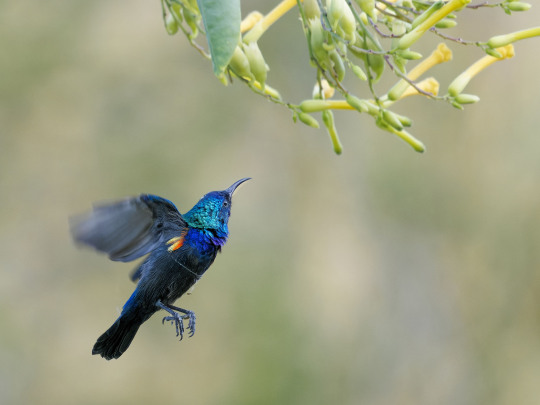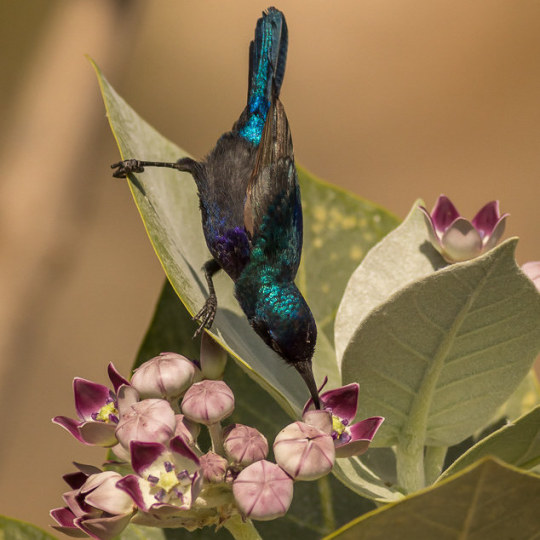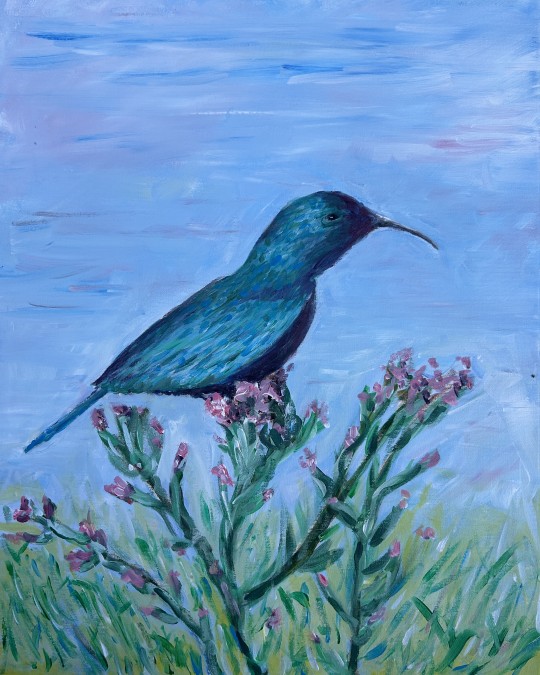#Cinnyris osea
Explore tagged Tumblr posts
Text

A Palestine sunbird (Cinnyris osea) perches on a hibiscus
by Artemy Voikhansky
I have had several Palestinian bloggers reach out to this blog for help with their GoFundMe campaigns in dire need of donations. If you can spare even a few dollars for just one of these campaigns, it could change somebody's whole life. If you can't, please reblog this post and share to people who potentially can.
@ranin3344 - Help Rebuild Our Lives in Gaza After Devastating War €8,618 raised of €80,000 vetted by 90s-ghost
@majedgaza1 - Rebuilding Hope: A Gaza Family in Need of Your Help $4,886 raised of $70,000 appears to be vetted
@ronzaanqar - Helping Ahmed's Family: Escaping War to a New Life €59,330 raised of €75,000 vetted and on the spreadsheet
Mohammed M Siam - Help Mohammed Rebuild His Home And Complete His Education $15 raised of $25,000 vetted by association & extremely low on funds!!
@yosef-hussin - Evacuate Kareem & Carmen NOW from Gaza $12,037 raised of $50,000 vetted by 90s-ghost
@yasermohammad - Help my Uncel’s family , BE THE CHANGE €21,989 raised of €35,000 vetted by 90s-ghost
@anasbatran - help me save my family from the war on Gaza, $5,685 raised of $35,000, in the process of being vetted and seems legitimate
@samaagaza - Help me and my family in Gaza $1,075 AUD raised of $20,000, vetted as far as i can tell
@d-mohammed - Safe my Family €4,557 raised of €100,000 donation protected + campaign was verified at one point but the post for that can no longer be found
@familyetaf1234567 - Please help us get out of life's crises and the woes of war. €1,898 raised of €50,000 not yet vetted but ris is clean + donation protected
@asma-family - Help Asmaa Abed Find Safety $837 raised of $20,000 , not yet verified but donation protected
@severekidpersona - Help osama and his family in Gaza €60 raised of €37,000 not yet vetted/verified
#palestine sunbird#sunbirds#birds#cinnyris osea#cinnyris#Nectariniidae#passeriformes#aves#chordata#wildlife: palestine#palestine#gaza
220 notes
·
View notes
Text

Cinnyris osea (2024)
Artist: Michael Sawdon-Smith
acrylic on canvas, 40 x 50 cm
Palestinian Sunbird/Cinnyris osea
26 notes
·
View notes
Text

My attemp at painting the Palestine sunbird, the national bird of Palestine
22 notes
·
View notes
Text

Palestinian Sunbird - Cinnyris osea
In 2015, the Palestinian Authority adopted the species as a national bird, after losing in Israel's national bird public vote in 2008, and after Israel's 2013 campaign to remove "Palestine" from the bird's common name. The specific name osea is derived from Ancient Greek ὁσια (hosia, "holy").
30 notes
·
View notes
Text

This year's Inktober is about Palestine.
Day 2: the Palestinian sunbird (Cinnyris osea). It has a curved beak because it feeds on flower nectar (but also insects!)
7 notes
·
View notes
Note
I wanna see some middle eastern birds
And so you shall...

Palestine Sunbird (Cinnyris osea), male, family Nectariniidae, order Passeriformes, found in parts of the Middle East and Northern Africa
photograph by Hasan Rimawi Photographer

Pied Kingfisher (Ceryle rudis), family Alcedinidae, order Coraciiformes, Saudi Arabia
photograph by Munzir Khalid Khan

Diederik Cuckoo (Chrysococcyx caprius), family Cuculidae, order Cuculiformes, found throughout much of Africa and the Middle East
Photo: @rockjumper_birding_tours

Cream-colored Courser (Cursorius cursor), parent with chicks, fdamily Glareolidae, order Charadriiformes, found in North Africa and the Middle East
photograph by Seyed Babak Musavi

Pin-tailed Sandgrouse (Pterocles alchata), family Pteroclidae, order Pterocliformes, Iran
photograph by Seyed Babak Musav

Northern Lapwing (Vanellus vanellus), family Charadriidae, order Charadriiformes, Kuwait
photograph by Shajahan Valiyakath

Arabian Green Bee-eater (Merops cyanophrys), family Meropidae, order Coraciiformes, found on and near the Arabian Peninsula and into the Levant
photograph by רסמי אבו

Eurasian Sparrowhawk (Accipiter nisus), male, family Accipitridae, order Accipitriformes, Kuwait
photograph by Shajahan Valiyakath
867 notes
·
View notes
Text



The Palestine Sunbird Persists
The Palestine sunbird, also known as the orange-tufted sunbird (Cinnyris osea) is the national bird of Palestine, and often seen as a symbol of resistance and hope. This species occurs in dry climates, particularly desert, scrubland, and savannahs, but can also be found in orchards and gardens where flowers are abundant. In addition to the Levant, C. osea occurs throughout the southwest cost of Saudia Arabia and the coasts of Yemen and Oman in the south.
C. osea is a small bird, 8 to 12 cm (3.1-4.7 in) long with a wingspan of only 14 to 16 cm (5.5-6.2 in). Males weigh on average 7.6 g (0.26 oz) and females are slightly smaller, at about 6.8 g (0.24 oz). Males are quite easy to identify due to their striking plumage; their feathers are iridescent, appearing dark until they shimmer glossy blue or green, with orange tufts at the side of the breast. In contrast females are fairly drab; grey-brown with a lighter underside. The beaks of the Palestine sunbird are also noted for their distinctively long and curved, which they have developed to efficiently feed on nectar.
Although not directly part of the hummingbird family, the Palestine sunbird shares many similarities with the group. Its diet consists of nectar, and is supplemented with insects. Their tongues are long, and brush-like, and the shape of their beak allows them to reach down to the base of the flower. For flowers that are , they will use their sharp beaks to pierce the side and access the nectar directly. All this is done at very high speeds, but unlike hummingbirds the Palestine sunbird cannot hover in place, and must land in order to feed. Because of their primary reliance on nectar, the orange-tufted sunbird is an important pollinator in its native region. Adults are rarely predated upon, but eggs and young are often targets for lizards, snakes, and birds of prey.
Reproduction begins in June, and continues through October. Males establish and defend territories, and court females by singing to attract a potential mate, then chasing her until she perches to signal her acceptance. Following the pairing, the two construct a purse-like nest, sometimes with a porch-like structure, that hangs from a branch. In this nest, 1-2 eggs are laid, and are incubated primarily by the female, while the male provides her food. The eggs take 13 to 14 days to hatch, and chicks are taken care of by both parents for an additional 14 to 21 days. Individuals can live up to 5 years in the wild.
Conservation status: The Palestine sunbird has a large range and population, and is thus considered Least Concern by the IUCN. Its primary threat is habitat loss due to agriculture and urban development.
If you send me proof that you’ve made a donation to UNRWA or another organization benefiting Palestinians, I’ll make art of any animal of your choosing.
Remember, the donation can be in any amount– every dollar counts!
Photos
Jorrit Vlot
Dula Alhashimi
Rana Hijawi
#Palestine sunbird#Passeriformes#Nectariniidae#sunbirds#perching birds#birds#deserts#desert birds#scrubland#scrubland birds#savannah#savannah birds#urban fauna#urban birds#middle east#animal facts#biology#zoology#ecology#free palestine
1K notes
·
View notes
Text

Palestine sunbirds (Cinnyris osea) and poppy anemones (Anemone coronaria)
🡢 this art is available as a t-shirt benefiting MAP (Medical Aid for Palestinians) through Sept. 5th 2024
440 notes
·
View notes
Text

palestine sunbird, or cinnyris osea, roughly greek for "holy little bird"
esims · urgent fundraisers · daily clicks
482 notes
·
View notes
Text

Palestine Sunbird (Cinnyris osea) © Steven Mlodinow
Arab.org
Children's Relief Fund
Care For Gaza
192 notes
·
View notes
Text
Poems of Palestine
There is a Holocaust in the Holy Land. I see it on my screen. A grandfather cries, Maryam is gone, Maryam is gone. She is small in the cradle of her family's arms. Her mother begs for the hair tie she had worn. There is a Holocaust in the Holy Land. And all I can do is scream. And scream. And scream.
One day I will walk from Ramallah. One day my friend will walk from Gaza. We will meet in the middle. I will tell her of my olive trees. Of the birds who sing. She will tell me of her sea. Of the fish it brings.
And how many times can a heart break, they ask. As many times as it beats. And a thousand times beyond that.
Remember the Crocodile. The time of my parents, my grandparents, and those before. They killed the Crocodile.
Remember the Fox. My time. The time of war. They have cut our numbers down, but we were never just numbers. The Fox will endure.
Remember the Sunbird. This will be the time of our children. This will be the days not yet born. This will be the hope, That keeps the Fox warm.
The Gaza night sky is painted with a blood red hue. The cry rings out “O God, we only have you, oh God!” Cut off from the world. They cut my heart. I hear it in my dreams, And waking moments too.
The Olive Trees are watered with the blood of Palestinians. They will bear witness long after the blood has dried.
I write as a way to express my emotions. I've witnessed so much these last few months and poetry is something that I am deeply connected with. I share some of my works on the day of the world strike for Palestine and hope that the future of a free Palestine will happen in my lifetime.
Holocaust in the Holy Land refers to one of the victims of the Israeli genocide. I watched a video of a family, and it broke me terribly inside. I cried for days. The young girl was being held by her family and her mother begs to have her hair tie to remember her by. Someone, whom I assumed to be her grandfather, was crying that Maryam is gone, in Arabic. It made me think of the Mary that the whole world knows, and how thousands of years later her namesake is being killed by the Zionist colonizers.
I have a friend in Gaza, as of writing this post she is still alive but we have only had a few messages of contact for the last couple of months due to the Israeli Occupation cutting off the internet. I worry for her constantly in my day to day life and I check the list of the martyred to make sure her name isn't on there. I worry that one day she will be but I hope that she isn't.
The Palestinian Crocodile went extinct in 1935 during the British Mandate. The Palestinian Fox is rare and in the recent Israeli Genocide the ones in the Gaza zoo were killed due to the Occupation's bombardment causing the caretakers to be unable to care for them. The Palestinian Sunbird is the national bird of Palestine, whom the Israeli Occupation tried to stop from becoming a symbol for Palestine.
Crocodylus Niloticus - Palestinian Crocodile
Article link
Vulpes Vulpes Palaestina - Palestinian Red Fox

Cinnyris Osea - Palestinian Sunbird

35 notes
·
View notes
Text

A male Palestine sunbird (Cinnyris osea) feeds from flowers in Oman
by Iordan Hristov
Donate to the Palestine Childrens Relief Fund
Donate to Medical Aid for Palestinians
Donate E-Sims to Gaza
#palestine sunbird#sunbirds#birds#cinnyris osea#cinnyris#nectariniidae#passeriformes#aves#chordata#wildlife: oman#wildlife: asia
503 notes
·
View notes
Text






Cinnyris osea (2024)
Artist: Michael Sawdon-Smith
acrylic on canvas, each painting 40 x 50 cm
Palestinian Sunbird/Cinnyris osea
#sunbird#palestinian sunbird#new artist#artists on tumblr#free palestine#Cinnyris osea#birds#wild birds#bird art
23 notes
·
View notes
Text

"Palestine sunbird (Cinnyris osea osea) male in flight" by Charles J. Sharp is licensed under CC BY-SA 4.0.
22 notes
·
View notes
Text

Sleeping sunbird
(To be specific, a male Palestine sunbird AKA Cinnyris osea)
6 notes
·
View notes
Note
Hey, I really hate to be this person, but I suspect that your Palestine sunbird stamp art might actually be referenced off the wrong species - I don't know if you're aware but there is another species more commonly known as the orange-tufted sunbird, Cinnyris bouvieri (the Palestine sunbird is Cinnyris osea), which occurs in Africa. C. bouvieri has a green throat & blue & red patches on the chest, while the Palestine sunbird has a more uniformly purplish throat & chest with no red markings.

It's not a problem at all, I never want to make the wrong move, especially for such an important cause.
Looking through from my reference and Google, trying to figure out what caused this error, made me realize that that was exactly what you just described.
I mistakenly only searched for references under the 'orange-tufted sunbird' name, as it said "[Cinnyris osea] also known as the orange-tufted sunbird, a name also used for the similar Cinnyris bouvieri" on Wikipedia.
So I apologize for not double-checking the source material and painting a completely different bird for this, and thank you for bringing it to my attention!! I'm going to quickly edit and change the image. Hopefully people reblog the update instead of the error, even though the damage has been done 😔...
7 notes
·
View notes